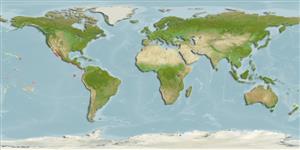分類 / Names
共通名の | 類義語 | Catalog of Fishes(部類, 種) | ITIS | CoL | WoRMS | Cloffa
>
Blenniiformes (Blennies) >
Blenniidae (Combtooth blennies) > Blenniinae
Etymology: Plagiotremus: Greek, plagios = oblique + Greek, trema = hole (Ref. 45335).
More on authors: Jordan & Bollman.
Environment: milieu / climate zone / depth range / distribution range
生態学
海 関連する礁; 深さの範囲 2 - 23 m (Ref. 5227). Tropical
Eastern Pacific: Gulf of California to Peru, including the Galapagos Islands (Ref. 5227).
サイズ / 重さ / 年齢
Maturity: Lm ? range ? - ? cm
Max length : 10.0 cm TL オス/雌雄の選別がない; (Ref. 11482)
Adults live in empty tube-worm snail shells, often extending the head from the opening. They feed by joining loose groups of look-alike rainbow wrasse and darting out to nip at nearby fish, taking mucus and perhaps small bits of flesh (Ref. 5227). The skin of larger fishes is the mainstay of the diet, although they are also known to eat eggs (Ref. 28023). Oviparous (Ref. 205). Eggs are attached to the walls of the parent's shelter and are brooded by the male parent (Ref. 56053). Larvae are planktonic, often found in shallow, coastal waters (Ref. 94114).
Life cycle and mating behavior
Maturities | 繁殖 | Spawnings | Egg(s) | Fecundities | 幼生
Oviparous, distinct pairing (Ref. 205). Males guard the eggs until they hatch (Ref. 56053).
Allen, G.R. and D.R. Robertson, 1994. Fishes of the tropical eastern Pacific. University of Hawaii Press, Honolulu. 332 p. (Ref. 11482)
Human uses
用具
特記事項
XMLをダウンロードして下さい
インターネットの情報源
Estimates based on models
Preferred temperature (Ref.
123201): 22.5 - 29.1, mean 27.1 °C (based on 214 cells).
Phylogenetic diversity index (Ref.
82804): PD
50 = 0.5005 [Uniqueness, from 0.5 = low to 2.0 = high].
Bayesian length-weight: a=0.00562 (0.00258 - 0.01228), b=3.06 (2.87 - 3.25), in cm total length, based on LWR estimates for this (Sub)family-body shape (Ref.
93245).
栄養段階 (Ref.
69278): 4.4 ±0.78 se; based on food items.
回復力 (Ref.
120179): 高い, 15か月以下の倍増期間の最小個体群 (Preliminary K or Fecundity.).
Fishing Vulnerability (Ref.
59153): Low vulnerability (10 of 100).
Nutrients (Ref.
124155): Calcium = 128 [65, 229] mg/100g; Iron = 0.812 [0.458, 1.384] mg/100g; Protein = 18.6 [17.5, 19.7] %; Omega3 = 0.112 [0.060, 0.208] g/100g; Selenium = 21.2 [10.0, 49.6] μg/100g; VitaminA = 264 [93, 733] μg/100g; Zinc = 1.46 [0.93, 2.17] mg/100g (wet weight);
